30 October 2019
By: Audrey Ferdinand
Introduction
The discovery of the neutron in 1932 and of artificial radioactivity in 1934 led to experiments and researches, especially in the US and in Germany, and to the finding that the fission of neutron can lead to a chain reaction, and thus the creation of a super-weapon.
The first test of a nuclear weapon has been carried out by the US in July 1945, followed, less than one month later, by the dropping of the bombs on Hiroshima and Nagasaki.
These attacks, and the numerous tests of nuclear weapons carried out by many States since 1945 raised concerns among the population about the use of such weapons and their subsequent consequences.
This article aims to shine a light on the issue of nuclear weapons as a death threat to humanity and the earth. Indeed, the number and power of weapons currently existing could destroy all life on earth. Being aware of this possible consequence, why do States create and store nuclear weapons (I), how are these controlled (II), and what are the prospects for the future (III)?
I. Nuclear weapons in the world
1. Context of the creation of nuclear weapons
History of the discovery of fission
In 1932, James Chadwick discovered the neutron and, in 1934 Frédéric and Irène Joliot-Curie discovered artificial radioactivity. Enrico Fermi performed experiments on the neutron by exposing many elements to low-speed neutrons and discovered that when exposing thorium and uranium, new elements were formed.
Otto Hahn and Fritz Strassman discovered that bombarding uranium with neutrons resulted in a radioactive barium isotope, the low-speed neutrons causing the uranium nucleus to fission. The combined atomic numbers of the two pieces resulting from the fission equalled that of the uranium nucleus.[1]
Lise Meitner – a colleague of Hahn – and her nephew Otto Frisch confirmed the results. Frisch then informed Niels Bohr, who was about to visit the United States, and subsequently reported the news to his colleagues there. Bohr worked with John Wheeler and discovered that “If the proper amount of material were assembled, these free neutrons might create a chain reaction. Under special conditions, a very fast chain reaction might produce a very large release of energy – in short, a weapon of fantastic power might be feasible.”[2]
How the development of the atomic bomb became a State issue
Albert Einstein, who was living in the US, reported to the then US president Franklin D. Roosevelt that Germany could develop an atomic bomb first. In reaction, Roosevelt appointed an Advisory Committee on Uranium which reported, in November 1939, that a chain reaction of uranium was possible and confirmed, in March 1940, that the isotope uranium-235 was responsible for low-speed neutron fission in uranium.[3]
In 1941, the US entered World War II and subsequently increased the funding towards realising the nuclear weapon. This has been called the Manhattan Engineer District project – known as the Manhattan project – and led under the responsibility of the US Armed Corps of Engineers. In 1942, Fermi and other researchers used high-purity carbon for the experiment, which led to the world’s first controlled nuclear chain reaction.[4] The first testing of a nuclear weapon ever, named “Trinity”, was conducted on 16 July 1945 at the Alamogordo Bombing Range in New Mexico.
The US successfully developed a nuclear weapon before the end of the war. This bomb took years to be designed and tested and, less than three weeks after the first trial, it was used for the first time in warfare, on Hiroshima and Nagasaki.
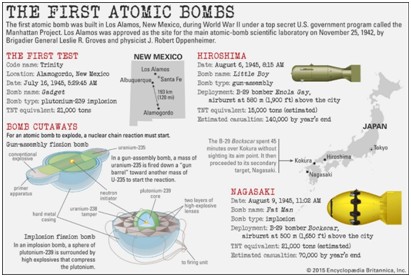 Source: Encyclopaedia Britannica
Source: Encyclopaedia Britannica
2. Nuclear weapon stockpiles
Historical stockpile and development of nuclear weapons
Many scholars have outlined that States will develop nuclear weapons, or seek to do so, when they are under a threat that cannot “be met through alternative means”.[5] We can see in the chart below that warheads increased heavily and quickly from mid-1950s to the end of 1980s, which coincide with the Cold War and its subsequent ending. Since the end of the Cold War, less countries are developing such weapons, many have stopped trying to, and got rid of their existing weapons.
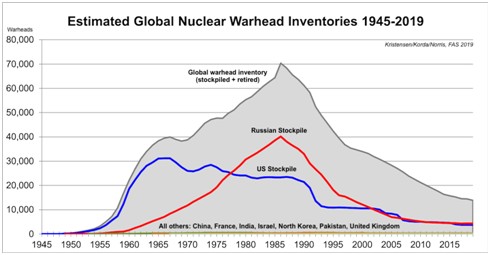 Source: Kristensen, Korda, and Norris, FAS 2019
Source: Kristensen, Korda, and Norris, FAS 2019
In the years preceding World War II and during this war, many countries tried to develop the atomic bomb. The US has been the first to do so, and the only one to use it during war times. In parallel, other countries researched on atomic bombs.[6]
It is possible to list State in three different categories:
- The nuclear-weapon states (NWS)
They are the five states that are officially recognised as possessing nuclear weapons by the NPT. Namely, China, France, Russia, United Kingdom, and the US. As we know now, the US tested and used the atomic bomb in 1945.
Russia / the Soviet Union established in 1939 that fission of uranium may lead to a chain reaction, but the experiments had been halted by the German invasion in 1941. The researches resumed after the bombing of Hiroshima and Nagasaki, leading to the conduct of the first soviet test on 29 August 1949. The United Kingdom tested “Hurricane” on 3 October 1952 aboard the frigate HMS Plym. By early 1954, Royal Air Force Canberra bombers were armed with atomic bombs.
France tested the atomic bomb for the first time on 13 February 1960 in the Sahara. In the following six years, France carried out three other atmospheric tests and 13 underground tests in Algeria, before moving the testing sites to the atolls of Mururoa and Fangataufa in the Pacific Ocean. France conducted 194 tests in the Pacific from 1966 to 1996.
After the end of the civil war in 1949 and the establishment of communist leadership, the main threat to China was the US. Fearing military action from the US, including the use of nuclear weapons, China sought to develop the same weapons as deterrence. Between 1964 and 1996 China conducted 23 atmospheric and 22 underground tests.
- The non-NPT nuclear weapons possessors
India, Israel, and Pakistan never joined the NPT but are known to possess nuclear weapons.
Israel never acknowledged the fact that it possessed nuclear weapons but is believed to be the sixth country to develop such weapons, and that a test had been carried out on 22 September 1979.
India tested a nuclear weapon on 18 May 1974 at the Pokhran test site on the Rajasthan Steppe.
In response to the Indian test, Pakistan sought to develop a nuclear weapon and claimed that a successful test had been conducted on 28 May 1998 in the Ros Koh Hills in the province of Balochistan.
- The States that had nuclear weapons or nuclear weapons programs at some point[7]
Belarus, Kazakhstan, and Ukraine inherited nuclear weapons following the collapse of the Soviet Union in 1991. Nevertheless, they returned the weapons to Russia and joined the NPT as non-nuclear-weapon states, in 1993 and 1994.
South Africa secretly developed a small number of nuclear warheads in response to growing fear near its borders but dismantled it and joined the NPT in 1991.
Iraq conducted research on the nuclear weapons prior to the 1991 Gulf War.
Libya voluntarily renounced its secret nuclear weapons efforts in December 2003.
Argentina, Brazil, South Korea, Sweden, Switzerland, Taiwan, Japan, and Germany have had such programmes at some point, but which never led to the creation of nuclear weapons.[8]
Current stockpiles
As of 2019, 13,865 nuclear weapons are identified throughout the world, the US and Russia owning more than 90 per cent of the weapons.[9]
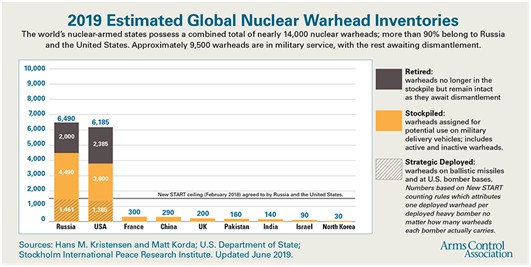 Reference for the Chart: Stockholm International Peace Research Institute
Reference for the Chart: Stockholm International Peace Research Institute
Current concerns
Iran recently announced it will no longer respect the “law-enriched uranium” limit established under the Joint Comprehensive Plan of Action (JCPOA), that has been adopted in 2015. While Russia estimates that no breach of the agreement has been made, the EU urged Iran to respect its obligations in a joint statement with the UK and German foreign ministers, issued in May 2019.[10]
The decision of Iran undermines the international order and security and violates its international obligations.
North Korea launched a nuclear weapon programme in the 1960s. This programme was effectively frozen between 1994 and 2002 as a result of an agreement with the US. But, in 2002 the US accused North Korea to having resumed its programme and, in response, North Korea decided to opt out from the NPT – the only country that has done so.
It is worrying to note that in the past 20 years, the DPRK carried out several nuclear tests and continues to try developing nuclear weapons.[11] The development of the DPRK nuclear programme disregards the international community’s demands and creates concerns[12], especially for neighbouring countries that can be affected by the testing of such weapons.
II. The need to control nuclear weapons
1. Results of nuclear war
The use of nuclear weapons is destructive and inhumane, many people being burned alive when close to ground zero, and the others having lasting diseases. The number of casualties caused by a single bomb cannot be exactly known, as many diseases may result to the exposure on radiations.
If several bombs were used, this could permanently damage the earth and disrupt the climate, leading to episodes of famines[13] – for those who survived the blasts.
Nuclear weapons have been used twice: on Nagasaki and Hiroshima (Japan), during World War II. Hundreds of civilians died, raising the question of the indiscriminate and lack of proportionality of such attacks.
The bomb launched over Hiroshima had “an explosive yield equal to 15,000 tonnes of TNT”, ground temperatures reached 4,000°C and radioactive rain poured down. This led to the destruction and burning of 70 per cent of the city and it is estimated that the blast is responsible for 140.000 deaths between 6 August 1945 and the end of the year. The bomb launched over Nagasaki on 9 August 1945 was slightly larger and approximately 74.000 people were killed as a result by the end of 1945.[14]
One main issue is that this indiscriminate attack also affected hospitals and doctors. Most of the medical personnel and facilities were killed or destroyed and only a few were able to take care about the injured. This resulted in the death of many people, without any possibility to ease their sufferings.
In several cases, people coming from other cities the help after the blast also died from the effects of radiations.
The consequences of the bombing have been felt even after the blast, with a high increase firstly of leukaemia, and then of all types of cancer – particularly thyroid, breast, and lung cancer. Pregnant women experienced high rates of miscarriage, many of children exposed to radiation – in the womb or directly – either died of a young age or were likely to suffer from intellectual disabilities and develop cancer.[15]
In Nagasaki and Hiroshima, the survivors of the blast have been called the “hibakusha” – “irradiated person”. Suffering from diseases, hibakushas were often deformed or had visible injuries, which led many of them to live in reclusion. But others have used their status and personal experience to promote peace and work towards a world free of nuclear weapons.[16]
2. Opposition to nuclear
The researches undertaken to create the nuclear weapon was quite unknown of the public before the drop of the atomic bombs on Hiroshima and Nagasaki in August 1945. Even though nuclear tests have been carried out before, the public became concern about such tests in the mid-1950s, following intensive tests in the Pacific. In 1963, many countries ratified the Partial Test Ban Treaty which prohibited atmospheric nuclear testing.
General discontent and will to no use nuclear, either as weapons or nuclear reactors, arose at during the 1970s. Many protests have been organized following the 1979 Three Mile Accident in the US, where a nuclear reactor partially melted down; other protests in Spain and Germany were organized even though no accident were reported. Following the Chernobyl disaster, people marched in Italy and other European countries.
The incident in 2011 in Fukushima, Japan, revived the opposition to nuclear in all its forms. Mostly pacifist NGOs voiced against the use of nuclear weapons but recently politicians and former military leader advocated against it.[17]
At the international level, the UN Secretary General published, in 2018, an Agenda for Disarmament[18], which links disarmament and the SDGs. This Agenda explains the importance of disarmament for peace, security, and the well-being of future generations, while providing with a list of actions that can be taken by States and other stakeholders in this aim.
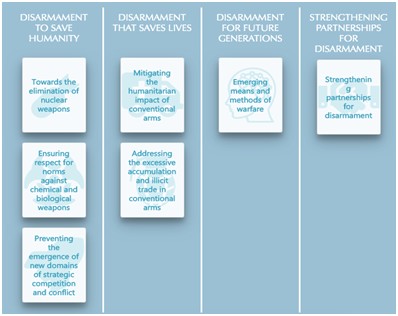 Source: UN.org
Source: UN.org
3. Efforts to control nuclear weapons
Control of the proliferation of nuclear weapons
- Treaty on the Non-Proliferation of Nuclear Weapons, 1968 (NPT)
The TNPNW aims to prevent the spread of nuclear weapons and weapons technology, to encourage the peaceful uses of nuclear energy, and to reach for the goal of disarmament.[19]
The TNPNW entered into force on 5 March 1970, with currently 191 State parties and 93 signatories.[20] This treaty is reviewed every five years by a review conference, which assess its implementation.
- Treaty on the Prohibition of Nuclear Weapons, 2017 (TNPW)
The TPNW prohibits the development, testing, producing, acquisition, possession, stockpiling and use or threat of using nuclear weapons. It further prohibits to deploy nuclear weapons on national territory and to provide assistance to any State in the conduct of prohibited activities.
Under the TNPW, State parties will be obliged to prevent and suppress any activity prohibited that is being undertaken by persons or on territory under its jurisdiction or control.
The TNPW further provides that States parties must provide adequate assistance to individuals affected by the use or testing of nuclear weapons, and take necessary and appropriate measure of environmental remediation in areas under its jurisdiction or control contaminated as a result of activities related to the testing or use of nuclear weapons.[21]
Unfortunately, this treaty, to which 26 State are currently parties, and 70 signatories, is not yet in force.[22] Indeed, the Treaty specifies, in its article 3, that “The Treaty on the Prohibition of Nuclear Weapons shall enter into force 90 days after 50 States have deposited their instrument of consent to be bound (ratification, acceptance, approval or accession).” The signature is not, therefore, taken into account for the treaty to enter into force.
Control of the testing of nuclear weapons
- Treaty Banning Nuclear Weapon Tests in the Atmosphere, in Outer Space and Under Water, also known as the Partial Test-Ban Treaty, 1963.[23]
Under this treaty, nuclear weapon tests are forbidden in Atmosphere, in Outer Space and Under Water, and therefore are still authorised on land.
This treaty was adopted on 5 August 1963 and entered into force on 10 October 1963 with 125 State parties and 104 signatories.
- Comprehensive Nuclear-Test-Ban Treaty,1996 (CTBT)[24]
To go further than the previous treaty, the CTBT “bans all nuclear explosions on Earth whether for military or for peaceful purposes.” It prohibits States Parties from carrying out any nuclear explosion and further prohibits any encouragement of or participation in the carrying out of any nuclear explosion. It provides for the establishment of the Comprehensive Nuclear-Test-Ban Treaty Organization in Vienna to ensure the Treaty's implementation as well as providing a forum for consultation and cooperation.[25]
Unfortunately, this treaty is not yet into force, although it has 168 State parties and 184 signatories.[26]
Control of the location of nuclear weapons
General treaties on the non-proliferation and elimination of nuclear weapons are completed by nuclear-weapons-zone-free (NWFZ) treaties.
In 1975, the General Assembly adopted a resolution on Nuclear-Weapon-Free-Zones, which provides that “The establishment of Nuclear-Weapon-Free Zones is a regional approach to strengthen global nuclear non-proliferation and disarmament norms and consolidate international efforts towards peace and security. Article VII of the Nuclear Non-Proliferation Treaty (NPT) states: “Nothing in this Treaty affects the right of any group of States to conclude regional treaties in order to assure the total absence of nuclear weapons in their respective territories”.[27]
It then defines a Nuclear-Weapon-Free Zone as “any zone recognized as such by the General Assembly of the United Nations, which any group of States, in the free exercises of their sovereignty, has established by virtue of a treaty or convention whereby:
(a) The statute of total absence of nuclear weapons to which the zone shall be subject, including the procedure for the delimitation of the zone, is defined;
(b) An international system of verification and control is established to guarantee compliance with the obligations deriving from that statute.”
The following treaties form the basis for the existing NWFZs:
- Treaty for the Prohibition of Nuclear Weapons in Latin America and the Caribbean (Treaty of Tlatelolco), with 33 State parties. Adopted in 1967, the entry into force is up to each country.[28]
- South Pacific Nuclear Free Zone Treaty (Treaty of Rarotonga), with 13 State parties. Adopted in 1985, it entered into force on 11 December 1986.[29]
- Treaty on the Southeast Asia Nuclear Weapon-Free Zone (Treaty of Bangkok), with 10 States parties. Adopted in 1995, it entered into force on 27 March 1997.[30]
- African Nuclear-Weapon-Free Zone Treaty (Treaty of Pelindaba), with 40 State parties and 51 signatories. Adopted in 1996, it entered into force more than ten years later, on 15 July 2009.[31]
- Treaty on a Nuclear-Weapon-Free Zone in Central Asia (CANWFZ), with 5 States parties. Adopted in 2006, it entered into force on 21 March 2009.[32]
- Mongolia’s self-declared nuclear-weapon-free status has been recognized internationally through the adoption of UN General Assembly resolution 55/33S on “Mongolia’s international security and nuclear weapon free status.”[33]
Other treaties that also deal with the denuclearization of certain areas are:
- Antarctic Treaty, with 51 State parties and 12 signatories. Adopted in 1959, it entered into force on 23 June 1961.[34]
- Treaty on Principles Governing the Activities of States in the Exploration and Use of Outer Space, including the Moon and Other Celestial Bodies (Outer Space Treaty), with 109 State parties and 89 signatories. Adopted in 1967, it entered into force on 10 October of the same year.[35]
- Treaty on the Prohibition of the Emplacement of Nuclear Weapons and Other Weapons of Mass Destruction on the Sea-Bed and the Ocean Floor and in the Subsoil Thereof (Seabed Treaty), with 94 State parties and 84 signatories. Adopted in 1971, it entered into force on 18 May 1972.[36]
Other instruments on nuclear free zones:
- Agreement Governing the Activities of States on the Moon and Other Celestial Bodies (Moon Agreement), adopted by the UN General Assembly in 1979.[37]
- Resolution on the Establishment of a nuclear-weapon-free zone in the region of the Middle East (A/RES/72/24).
It is regrettable that the US, Canada, Europe and most of Asia are not areas covered by nuclear weapons free treaties or agreements.
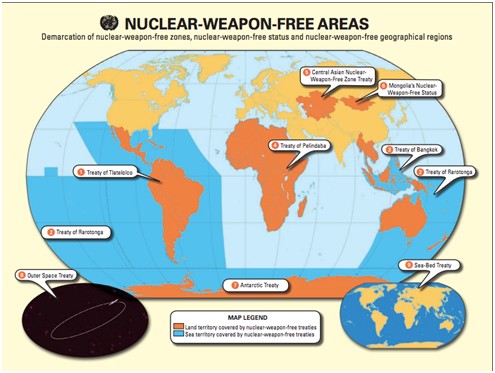 Source: UN Office for Disarmament Affairs UNODA[38]
Source: UN Office for Disarmament Affairs UNODA[38]
Expert control
In addition to treaties, a number of “expert control groups” [39] have been created to contribute to the prevention and proliferation of weapons of mass destruction. Five groups are currently in place:
- The Australia Group[40] includes 42 States participants – plus the European Union – and one adherent to its guidelines and control lists: Kazakhstan, that adhered in 2015. This group aims to create guidelines to avoid the proliferation of chemical and biological weapons.
- The Missile Technology Control Regime (MTCR)[41] has 35 States participants and three adherents. This group aims to limit the proliferation of missiles and missile technology by providing guidelines to States.
- The Nuclear Suppliers Group (NSG)[42] has 48 States participants. This group of nuclear supplier countries developed two sets of guidelines for nuclear export and nuclear-related export, in order to contribute to the non-proliferation of nuclear weapons
- The Wassenaar Arrangement[43]. 42 States are participating to this arrangement, which aims to promoted transparency and greater responsibility in transfers of conventional arms and dual-use goods and technologies. States participating are required to provide reports regarding their arms transfer.
- The Zangger Committee[44] focuses on the interpretation of the NPT, to harmonise the understand and subsequent implementation of the Treaty by State parties.
4. Outlawing the weapons
Nuclear weapons include atomic bombs, hydrogen bombs and neutron bombs.
The atomic bombs dropped on Hiroshima and Nagasaki are not, as such, prohibited under international law. But testing, manufacturing and stockpiling such weapons are banned under several treaties – see the list of treaties above.
Then, arises the question of whether the use of the use of such bombs is legal under international law. In this aim, the UN General Assembly asked the International Court of Justice (ICJ) for an advisory opinion. The opinion, issued on 8 July 1996, concluded that the threat or use of nuclear weapons would generally be contrary to the rules of international law applicable in armed conflict, but did not stated per se that nuclear weapons were unlawful and let the door opened regarding the use of such weapons for self-defence, in the respect of the principle of proportionality.[45]
III. Prospects for the future
The situation in Iran and North Korea may be worrying, but the global picture is that most States do not have the nuclear weapon, and most of those who do are either disarming or bound by a treaty.
Nevertheless, the amount of warhead currently existing is still enough to blow up the whole earth in the event of a nuclear war. Even though nuclear weapons have been developed mainly for deterrence purpose, the possibility of their use presents a threat to humanity and to the world.
Therefore, GICJ believes it is necessary that all States stop from developing the nuclear weapons and that States who possess it refrain from helping other States acquiring it and work towards the dismantlement of such weapons.
GICJ calls on all States to ratify the existing instruments relating to the proliferation and testing of nuclear weapons.
GICJ appeals on the civil society to raise awareness on the issue of nuclear weapons and to join forces towards their total elimination.
[1] https://www.britannica.com/technology/nuclear-weapon/Residual-radiation-and-fallout
[2] https://www.britannica.com/technology/nuclear-weapon/Residual-radiation-and-fallout
[3] https://www.britannica.com/technology/nuclear-weapon/Residual-radiation-and-fallout
[4] https://www.britannica.com/technology/nuclear-weapon/Residual-radiation-and-fallout
[5] Scott Sagan, “Why Do States Build Nuclear Weapons? Three Models in Search of a Bomb,” International
Security, Vol. 21, No. 3 (Winter 1996/1997): 54-86.
[6] https://www.britannica.com/technology/nuclear-weapon/The-spread-of-nuclear-weapons
[7] https://www.armscontrol.org/factsheets/Nuclearweaponswhohaswhat
[8] https://www.britannica.com/technology/nuclear-weapon/Other-countries
[9] http://www.icanw.org/the-facts/nuclear-arsenals/
[10] https://www.armscontrol.org/factsheets/JCPOA-at-a-glance
[11] https://www.armscontrol.org/factsheets/dprkchron
[12] https://www.iaea.org/newscenter/news/iaea-director-general-provides-updates-on-iran-north-korea-at-board-of-governors-meeting
[13] http://www.icanw.org/the-facts/catastrophic-harm/
[14] http://www.icanw.org/the-facts/catastrophic-harm/hiroshima-and-nagasaki-bombings/
[15] http://www.icanw.org/the-facts/catastrophic-harm/hiroshima-and-nagasaki-bombings/
[16] https://www.un.org/disarmament/education/slideshow/hibakusha/
[17] https://www.economist.com/international/2011/06/16/the-growing-appeal-of-zero
[18] https://www.un.org/disarmament/sg-agenda/en/
[19] https://www.iaea.org/publications/documents/treaties/npt
[20] http://disarmament.un.org/treaties/t/npt
[21] https://www.un.org/disarmament/wmd/nuclear/tpnw/
[22] http://disarmament.un.org/treaties/t/tpnw
[23] http://disarmament.un.org/treaties/t/test_ban
[24] https://www.nti.org/learn/treaties-and-regimes/comprehensive-nuclear-test-ban-treaty-ctbt/
[25] https://www.ctbto.org/the-treaty/treaty-text/
[26] http://disarmament.un.org/treaties/t/ctbt
[27] https://www.un.org/disarmament/wmd/nuclear/nwfz/
[28] http://disarmament.un.org/treaties/t/tlatelolco
[29] http://disarmament.un.org/treaties/t/rarotonga
[30] http://disarmament.un.org/treaties/t/bangkok
[31] http://disarmament.un.org/treaties/t/pelindaba
[32] http://disarmament.un.org/treaties/t/canwfz
[33] http://www.un.org/ga/search/view_doc.asp?symbol=A/RES/55/33
[34] http://disarmament.un.org/treaties/t/antarctic
[35] http://disarmament.un.org/treaties/t/outer_space
[36] http://disarmament.un.org/treaties/t/sea_bed
[37] http://disarmament.un.org/treaties/t/moon
[38] https://unoda-web.s3-accelerate.amazonaws.com/wp-content/uploads/assets/WMD/Nuclear/pdf/NWFZ-postcard-2010.pdf
[39] https://www.un.org/disarmament/wmd/export-controls/
[40] https://australiagroup.net/en/
[41] https://mtcr.info/
[42] https://www.nuclearsuppliersgroup.org/en/
[43] https://www.wassenaar.org/
[44] http://www.zanggercommittee.org/
[45] https://legal-dictionary.thefreedictionary.com/Nuclear+Weapons
Legality of the Threat or Use of Nuclear Weapons, Advisory Opinion, 1.C.J. Reports 1996, p. 226, para. 39 and following.












